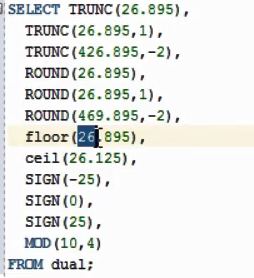
SELECT TRUNC(15.79), TRUNC(15.79,1), ROUND(15.79), ROUND(15.79,1), ROUND(115.79,-2), FLOOR(26.983), CEIL(26.123), SIGN(-25), SIGN(0), SIGN(25), MOD(10,4) FROM dual;
TRUNC(15.79) TRUNC(15.79,1) ROUND(15.79) ROUND(15.79,1) ROUND(115.79,-2) FLOOR(26.983) CEIL(26.123) SIGN(-25) SIGN(0) SIGN(25) MOD(10,4) ------------ -------------- ------------ -------------- ---------------- ------------- ------------ ---------- ---------- ---------- ---------- 15 15.7 16 15.8 100 26 27 -1 0 1 2
TRUNC:
Returns the number or expression passed as parameter
Syntax:
TRUNC(original_number[,n])
The parameter for the number of decimals (n
original number to convert it into an integer.
If n is negative, the function truncates n digits to the left of the decimal point.
ROUND:
Returns the number or expression passed as parameter
Syntax:
ROUND(original_number[,n])
The parameter for the number of decimals (n
original number to convert it into an integer.
If n is negative, the function rounds off n digits to the left of the decimal point.
FLOOR:
Returns the largest integer that is equal to or less than
decimals from the original number, if it is not an integer.
integer.
Syntax:
FLOOR(original_number)
CEIL:
Returns the smallest integer that is greater than or equal to
number passed has decimals it returns the next integer.
Syntax:
CEIL(original_number)
SIGN:
Returns a number that represents the sign of the number passed as parameter
number passed is positive it returns 1, and it returns 0 if the number passed is 0.
Syntax:
SIGN(number)
MOD:
Returns the remainder of the first_number divided by
Syntax:
MOD(first_number,second_number)